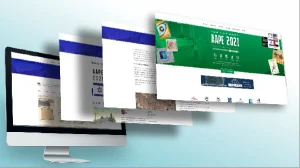Nowadays, and especially “during the Corona period”, many people and business owners understand that every business needs a website to succeed and be profitable. For many, this fact is a little stressful because most people are not able to build a professional website by themselves and therefore depend on external bodies.
Building professional websites is an art, but it also has a very analytical side that requires a correct strategy, the establishment of a customer journey and of course characterizing and mapping the website in the ultimate way.
The option of paying programmers and freelancers to build your business’s “identity card” for you always exists (and is usually also worthwhile), but it is important to note that this is a large financial investment and therefore it is important to prepare and be prepared accordingly – you do not want to end up in a situation where you are not aware of all the required costs and end up exceeding the budget .
There are 3 main things that you should be aware of before you start the process of building websites, developing an application or any establishment of a software house for your business. If you already have a website, the following information may help you understand why your website is not financially successful or “attracting” enough customers to it. Either way, just by considering the following steps, you can save yourself a lot of time, money and frustration trying to get your site working for you as it should.
Accurate strategy in building websites
The first step is one that people often struggle with, but once you get through it you will have an amazing strategy that will serve as a foundation for everything that needs to be done in the future. The main problem with making an accurate strategy is that people don’t really know where to start.
Most of the times, people know they need a website and have a vague idea of what purpose the website is supposed to serve, however, they haven’t really taken the time to map out what they want to present to the world about themselves and their business – building professional websites needs preparation and establishing a strategy according to stages in the exact way most.
The main point in all this is to create a successful website. To do this, you will need to spend time thinking about who you are and what you stand for, what you are passionate about and have a passion for and what are the core values of your business.
If you don’t know who you are, then how will you know what products to create for a website or how to present yourself on an image website? When you are unclear, that lack of clarity comes out and your website visitors will notes it.
It is entirely up to you if the message is clear and professional or if it is confusing. That is why it is so important that you start implementing a successful strategy even before building a professional website.

customer journey
Once you have established the core values of your business and according to which your website will be run, and when you know what message you want to convey to the people visiting the website, you can begin to predict what your website should include.
Now is the time to start considering what kind of “customer journey” you are leading the visitors who come to the site – first and foremost, you will want to consider what the visitor’s first impression will be when he lands on your home page. After all, first impressions are everything, aren’t they? Therefore, this is one of the most important details to consider while you are designing your website.
Another important aspect of all of these is a clear idea of who will be the optimal visitor to your website. Which audience are you targeting that will probably want your product or service – actually how do we get our customers to buy from us online? Much of what you include on your website will be based on the answer to this question.
For example, statistics show that young men and women spend an absolute majority of their time watching YouTube videos. This means that if your target audience is mainly made up of younger consumers, you may be able to get them to interact better with your website using media that includes videos rather than articles and articles. In other words, you need to consider what your primary visitors will enjoy and what will make them stay longer on your site. This will determine the type of content you want to include as you build the site.
Throughout, you need to remember your initial message as it is the foundation of your website strategy. You want to predict which customer journey each surfer will go through on your website. When the surfers move from one page to another, are you sending a clear message about the type of company and your brand? Which pages should be included that will make it easier for the surfer to navigate the site? What content will make them more likely to stay on the site, communicate and buy? These are all questions you should ask yourself before approaching a company that specializes in building a professional website.
Characterization and site map
When you’re planning your website and considering user experience, you’ll want to start mapping out all the pages you want to include. You probably have a general idea in your head of which pages will be the most “in demand” on your website, but actually putting pen to paper and drawing it (or in our case using advanced technology software) will help you see from a bird’s eye view which pages you need to build – this process is called characterizing a website and it is extremely critical.
A quality sitemap will start with understanding the main categories in your main menu. You can then associate the relevant product pages with each category if it is a sales site or the services you provide if it is an image site.
Be sure that when you properly map your site, you actually think about the user experience at every stage and how the surfers can easily find what they need.






